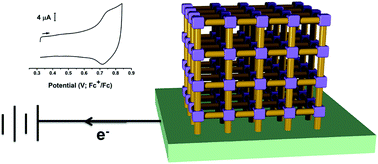当前位置:
X-MOL 学术
›
Chem. Sci.
›
论文详情
Our official English website, www.x-mol.net, welcomes your
feedback! (Note: you will need to create a separate account there.)
Characterisation of redox states of metal–organic frameworks by growth on modified thin-film electrodes†
Chemical Science ( IF 7.6 ) Pub Date : 2018-06-04 00:00:00 , DOI: 10.1039/c8sc00803e Tamoghna Mitra 1, 2 , Florian Moreau 1, 3 , Adam Nevin 1, 3 , Carlo U Perotto 1 , Alex Summerfield 4 , E Stephen Davies 1 , Elizabeth A Gibson 1, 5 , Timothy L Easun 1, 6 , Martin Schröder 1, 2
Chemical Science ( IF 7.6 ) Pub Date : 2018-06-04 00:00:00 , DOI: 10.1039/c8sc00803e Tamoghna Mitra 1, 2 , Florian Moreau 1, 3 , Adam Nevin 1, 3 , Carlo U Perotto 1 , Alex Summerfield 4 , E Stephen Davies 1 , Elizabeth A Gibson 1, 5 , Timothy L Easun 1, 6 , Martin Schröder 1, 2
Affiliation

|
The application of metal–organic framework (MOF) materials in electrochemical and electrochromic devices remains rare. One of the main reasons for this is the inability to readily access their detailed electrochemistry. The inherent insolubility of these materials does not allow interrogation by traditional solution-based electrochemical or spectroscopic methods. In this study, we report a straightforward alternative approach to the spectroelectrochemical study of MOFs. We have used two systems as exemplars in this study, MFM-186 and MFM-180. The method involves chemical modification of a working electrode to attach MOF materials without using corrosive reagents such as inorganic acids or bases which otherwise could limit their application in device development. MFM-186 demonstrates the formation of a stable radical species [MFM-186]˙+ on electrochemical oxidation, and this has been characterised by electrochemical, spectroelectrochemical and EPR spectroscopic techniques coupled to DFT analysis.
中文翻译:

通过在改性薄膜电极上生长来表征金属有机框架的氧化还原态†
金属有机骨架(MOF)材料在电化学和电致变色器件中的应用仍然很少。造成这种情况的主要原因之一是无法轻松获取其详细的电化学信息。这些材料固有的不溶性不允许通过传统的基于溶液的电化学或光谱方法进行研究。在这项研究中,我们报告了一种直接替代 MOF 光谱电化学研究的方法。我们在本研究中使用了两个系统作为范例:MFM-186 和 MFM-180。该方法涉及对工作电极进行化学修饰,以附着 MOF 材料,而不使用无机酸或碱等腐蚀性试剂,否则可能会限制其在设备开发中的应用。MFM-186 证明了电化学氧化时稳定自由基物质 [MFM-186]˙ +的形成,并且已通过电化学、光谱电化学和 EPR 光谱技术与 DFT 分析相结合对其进行了表征。
更新日期:2018-06-04
中文翻译:

通过在改性薄膜电极上生长来表征金属有机框架的氧化还原态†
金属有机骨架(MOF)材料在电化学和电致变色器件中的应用仍然很少。造成这种情况的主要原因之一是无法轻松获取其详细的电化学信息。这些材料固有的不溶性不允许通过传统的基于溶液的电化学或光谱方法进行研究。在这项研究中,我们报告了一种直接替代 MOF 光谱电化学研究的方法。我们在本研究中使用了两个系统作为范例:MFM-186 和 MFM-180。该方法涉及对工作电极进行化学修饰,以附着 MOF 材料,而不使用无机酸或碱等腐蚀性试剂,否则可能会限制其在设备开发中的应用。MFM-186 证明了电化学氧化时稳定自由基物质 [MFM-186]˙ +的形成,并且已通过电化学、光谱电化学和 EPR 光谱技术与 DFT 分析相结合对其进行了表征。











































 京公网安备 11010802027423号
京公网安备 11010802027423号